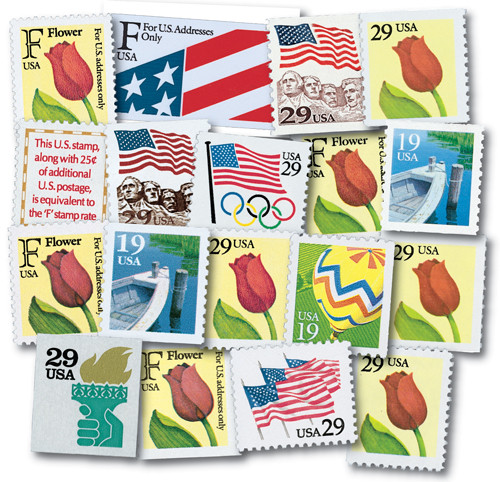
# 2522a - 1991 29c "F" Plastic Flag Stamp,pane(12)
US #2522a
1991 F-rate Flag
- Booklet Pane of 12
- Same design as 1990 plastic Flag stamp
- Intended for use in ATMs
- Issued in response to a rate increase for First-Class mail
Category of Stamp: Definitive
Value: 29¢
First Day of Issue: January 22, 1991
First Day City: Washington, DC
Quantity Issued: 25,500,000
Printed by: Avery International
Printing Method/Format: Photogravure, Panes of 12 (4 across, 3 down), from printing cylinders of 180 (15 across, 12 down)
Perforations: Die cut
Reason the stamp was issued: This stamp was issued as a result of a rate increase in early 1991. The format was part of an ongoing experiment using Automatic Teller Machines to dispense stamps.
About the stamp design: The same design was used as the previous ATM stamp. It shows a portion of the American flag. The 25¢ denomination on the original stamp was changed to reflect the “F” rate change. The color of the writing was also changed from red to black.
About the printing process: In order to be used in the ATMs, the stamps had to be the same size and thickness of dollar bills. The USPS developed a self-adhesive stamp made from polyester film rather than paper. Avery International, a company known for making self-adhesive labels, was awarded the contract to make these stamps.
First Day City: The F-rate Flag stamps were issued in Washington, DC, along with the rest of the F-rate change stamps. There was no official ceremony.
History the stamp represents: On May 18, 1990, the United States Postal Service began a six-month marketing test to sell stamps through Automated Teller Machines (ATMs). For this test, the USPS developed a stamp that was radically different from any it had previously issued. To meet the strict engineering requirements of ATMs, the stamps were made of a specially formulated polyester film. The panes of 12, which were the same size and shape as a dollar bill, were dispensed from the ATMs just like cash. In addition to offering customers the convenience of round-the-clock access to stamps, the ATM issues also offered the ease of peel-and-stick application with no licking or tearing.
With the 1991 rate increase, a new non-denominated stamp was issued. It was made of the same materials and had the same design, except the red “25¢” denomination was replaced with a black “F.” Though the rate change stamp was issued in Washington, DC, it was later only available in the Seattle, Washington, area where the experiment with the ATMs was taking place.
US #2522a
1991 F-rate Flag
- Booklet Pane of 12
- Same design as 1990 plastic Flag stamp
- Intended for use in ATMs
- Issued in response to a rate increase for First-Class mail
Category of Stamp: Definitive
Value: 29¢
First Day of Issue: January 22, 1991
First Day City: Washington, DC
Quantity Issued: 25,500,000
Printed by: Avery International
Printing Method/Format: Photogravure, Panes of 12 (4 across, 3 down), from printing cylinders of 180 (15 across, 12 down)
Perforations: Die cut
Reason the stamp was issued: This stamp was issued as a result of a rate increase in early 1991. The format was part of an ongoing experiment using Automatic Teller Machines to dispense stamps.
About the stamp design: The same design was used as the previous ATM stamp. It shows a portion of the American flag. The 25¢ denomination on the original stamp was changed to reflect the “F” rate change. The color of the writing was also changed from red to black.
About the printing process: In order to be used in the ATMs, the stamps had to be the same size and thickness of dollar bills. The USPS developed a self-adhesive stamp made from polyester film rather than paper. Avery International, a company known for making self-adhesive labels, was awarded the contract to make these stamps.
First Day City: The F-rate Flag stamps were issued in Washington, DC, along with the rest of the F-rate change stamps. There was no official ceremony.
History the stamp represents: On May 18, 1990, the United States Postal Service began a six-month marketing test to sell stamps through Automated Teller Machines (ATMs). For this test, the USPS developed a stamp that was radically different from any it had previously issued. To meet the strict engineering requirements of ATMs, the stamps were made of a specially formulated polyester film. The panes of 12, which were the same size and shape as a dollar bill, were dispensed from the ATMs just like cash. In addition to offering customers the convenience of round-the-clock access to stamps, the ATM issues also offered the ease of peel-and-stick application with no licking or tearing.
With the 1991 rate increase, a new non-denominated stamp was issued. It was made of the same materials and had the same design, except the red “25¢” denomination was replaced with a black “F.” Though the rate change stamp was issued in Washington, DC, it was later only available in the Seattle, Washington, area where the experiment with the ATMs was taking place.



